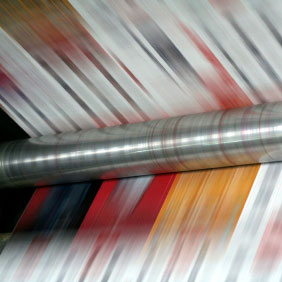Whether you’re new to the magazine publishing business or not, finding a solid, reliable company to outsource your design with is one of the most important tasks in setting up your team. Magazines are anything but a one-time engagement — for publishers with dreams of seeing their publication take off, their design firm can be a pivotal partner in the success of the venture for years to come. So it’s important to consider your options carefully, evaluate each designer thoughtfully and find the best possible fit for your needs. Toward that end, we’ve put together some points for you to consider in your selection process:
1. First and foremost, does the firm specialize in magazine design, how many years of experience in magazine design do they have under their belt, and how many high-quality magazine designs have they published? Magazine design is a unique specialty in the graphic design field, and one in which a relatively small number of designers have substantial experience. While a tri-fold brochure or business card may suit almost any designer’s talents, magazine design and layout requires a sustained level of creativity and the ability to create a design rhythm within a publication that makes it come together as an integrated whole — and makes it a joy for readers to peruse.
2. Does the firm’s range of design styles mesh well with the magazine you plan to publish? Take a good look at a design firm’s magazine portfolio. Do their design samples reflect the target audience to whom you plan to market your magazine? Make sure the magazine designer understands who your market is and what their preferences are — that will be essential to engaging the audience and critical to the success of your publishing venture.
3. Are they capable of producing issues reliably on an ongoing basis, according to the frequency of your magazine? Producing magazine issues can be a hectic business, and for magazines published monthly or more frequently, the production cycle is continuous, and often more than one issue is in production at the same time. Printer and distributor schedules require magazine production schedules to be carried out with diligent precision and impeccable reliability, and magazine publishers can’t afford to rely on a firm that doesn’t have a stellar track record with regard to meeting deadlines time and time again. Be sure to check client references and get a feel for the designer’s workload capacity, reliability and responsiveness under pressure.
4. If you’re relatively new to the publishing industry, is the design firm experienced with startup magazines and in guiding new magazine publishers through the design and layout process? Especially during the initial issues, publishing a magazine can be a challenging experience that requires publishers to absorb a lot of information quickly — and the designer will often need to provide guidance and expertise in order to ensure the highest-quality publication. If you aren’t completely comfortable with magazine publishing yet, make sure your designer is willing to help walk you through the publishing process — this is another great piece of information that can be vetted with client references.
5. Does the design company have expertise in creating magazine media kits, to assist you in marketing your publication to prospective advertisers? If your magazine includes advertising, then the financial success of your venture likely depends largely on filling that ad space. Magazine media kits (sales kits) are an essential tool for publishers to quickly make their pitch to advertisers, and the importance of planning and designing a dynamite kit can’t be overstated. Since your media kit should be co-branded with your magazine design, make sure your designer also has substantial experience in designing for the marketing side of the publishing business — not just the editorial (content) side.
6. How important is cost? In graphic design, “you get what you pay for” is an old adage very much to keep in mind as you go about selecting your magazine design team. While you don’t necessarily need the fanciest design studio with the slickest sales staff and the most modern office furniture (all of which can be pricey overhead that adds to your project cost), take care with whom you entrust the success of your publishing venture. As mentioned previously, magazine design can (and ideally should) be a long-term partnership, to ensure the stability, reliability and consistent design quality of magazine production from issue to issue and year to year. Use your best judgment when it comes to the long-term potential in your designer — and again, be sure to check those references. Quality is paramount with magazine design, and automatically going with the lowest bidder might be a decision you regret in the not-too-distant future. Consider the big picture before you sign on the dotted line.
7. How attentive are they to detail? For better or worse, creative personalities don’t always make for the most detail-oriented workers. But with so many moving parts and so many details to the magazine production process, having a designer with diligent attention to detail is of the utmost importance. Magazines contain a lot of content, and if you’re constantly dealing with someone who can’t quite manage the minutiae, mistakes are almost certainly going to be made — mistakes that will ultimately make you and your publication look less than world-class. So look for a healthy balance in your design firm. You’ll need a team with both top-notch creativity and a solid ability to get things done right — every time, on time, and without continual prodding on your part.
8. Does the designer provide in-house editorial services like copyediting and proofreading? A magazine’s editorial quality — which includes the flow, style and proofing standards of the copy, is every bit as important to the overall image of the magazine as the design quality. Nothing turns readers off like a story filled with grammatical errors, spelling mistakes and mediocre writing. Having your design firm handle the copyediting and proofing process can be a real time-saver and reduce the number of players in the overall magazine production process.
9. How well do you “click” with the person who will actually be in charge of your magazine production? And have you even spoken with them personally? After taking all the other factors into consideration, sometimes consulting your gut feeling is a good idea. Seeing that you’ll be working so closely with your design and layout team to produce issues on an ongoing basis, what kind of “vibe” do you have with them, and do you foresee a good working relationship going forward? And for that matter, have you actually talked to/met with the actual people who will be working on your magazine every day? You may have struck up a good conversation or two with the design firm’s sales rep, but if the project will soon be turned over to a surly designer or lackadaisical production assistant, that relationship may quickly lose its luster. Know who you’ll be dealing with, and be sure to speak directly with the folks who will actually be in charge of turning your vision into a work of art. Get a feel for them and how they like to work. And get a sense for how they work under pressure and how they respond to the demands of curve balls like a late story submission or a last-minute copy change. Soon that working relationship will be the foundation of your magazine’s production workflow, so be sure to familiarize yourself well with your partners. Once again, references are a great way to get this information from an unbiased point of view. Taking this and all the points mentioned above into consideration, you should be able to make a wise, informed decision and hit the ground running with the design of your first issue.

 Came across a great
Came across a great  Offset printing has come a long way since the days of typesetting, film and color separations. Gone are the days of camera-ready art and Stat cameras — these days, at least on large presses, it’s all digital.
Offset printing has come a long way since the days of typesetting, film and color separations. Gone are the days of camera-ready art and Stat cameras — these days, at least on large presses, it’s all digital.